Hå,Norway 作者: 来源: 发布时间:2021-02-20
一、所属省或是州,具体位置,人口,面积
Hå is a municipality in Rogaland county, Norway. It is the southernmost municipality in the traditional district of Jæren. The administrative center of the municipality is the village of Varhaug. Other villages in Hå include Brusand, Hæen, Nærbø, Obrestad, Ogna, Sirevåg, and Vigrestad.
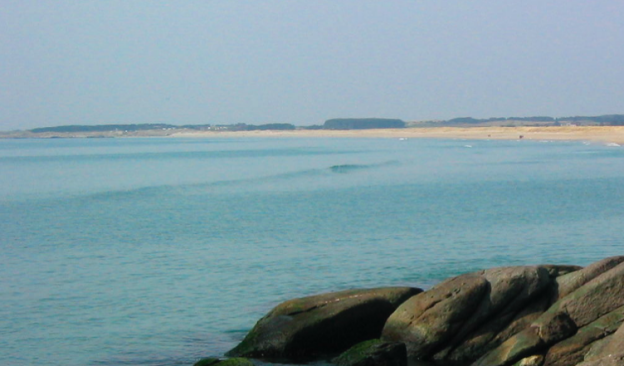
The 258-square-kilometer (100 sq mi) municipality is the 281st largest by area out of the 356 municipalities in Norway. Hå is the 66th most populous municipality in Norway with a population of 18,991. The municipality's population density is 76.6 inhabitants per square kilometer (198 / sq mi) and its population has increased by 16.2% over the previous 10-year period.
二、自然地理
1.地理条件
Hå municipality is located on the southwestern shore of Norway, along the North Sea. The municipality is located mostly in the very flat, coastal Jæren district. The southeastern part of the municipality begins to get a little hilly and rocky and it marks the border of the Dalane district (located to the south and east). Much of the land in Hå is used for agriculture because of its flat landscape. The river Hååna runs through the municipality. The shoreline of the municipality is marked by the Kvassheim Lighthouse and Obrestad Lighthouse.
The municipality has a 40 km long straight coastline with sand and pebble beaches. The sea is shallow and there are low moraine ridges in several places. Obrestad lighthouse is located on such a moraine ridge. At Ogna, the sandy beaches end and nature is rugged here and forms a natural harbor at Sirevåg. The entire beach zone is part of the Jærstrendene landscape conservation area. There is a rich bird and plant life in this area of the southwest. To the east, the landscape rises in gentle waves up to Høg-Jæren at 120 masl with heather and bog heaths.
Some unique groundwater layers have been discovered in Hå municipality that have not been seen before in this country. A survey drilled 126 meters into the earth and "200,000 years back in time" to gain more knowledge about Jæren's earth history. On the way down support drilled on two aquifers.
One groundwater reservoir was 3-12 meters below the surface, while the largest layer was 40 to 80 meters below the ground. They are on top of each other, but are completely separated from each other. The lower layer is free of agricultural contaminants and salt from the sea. Such groundwater may be relevant to use as drinking water when supplying smaller settlements in the municipalities or as reserve water sources.
2. 交通情况
The Sørlandet Line runs through the municipality, making several stops. The stations in Hå include Brusand Station, Nærbø Station, Ogna Station, Sirevåg Station, Varhaug Station, and Vigrestad Station. Hå municipality gives high priority to traffic safety through development / improvement of, among other things, road junctions and new sections with pedestrian and cycle paths.
Hå municipality prepares an annual traffic safety plan (separate chapter in the financial plan) which is politically discussed. The plan includes, among other things, priority areas for the development of pedestrian and cycle paths.
The county traffic safety committee in Rogaland (FTU) allocates traffic safety funds (TS funds) every quarter upon application from the municipalities. Hå municipality applies quarterly for funds based on adopting a traffic safety plan. Larger expensive projects, the municipality must allow its own funds for or seek cooperation and possible partial financing with the county municipality / the Norwegian Public Roads Administration.
https://www.ha.no/veg-trafikk-og-hamn/trafikksikkerhet/
三、经济发展和规模
The most important industry in Hå is agriculture (50%). The soil on Jæren is very rich in nutrients, and the climate is mild and wet. The landscape is flat agricultural land and intensive agriculture is practiced with significant milk production. Hå is Rogaland's largest agricultural municipality. The municipality also has industrial production of agricultural implements, as well as service industries.
Hå municipality has
• 84.2% tax revenue of the national average
• no property tax
• low municipal fees
• lowest in the country on administration in consequence
the municipal barometer
• large financial expenses due to large investments
• uncertain population growth
• more inhabitants with more complex needs
• And not least - how long does the pandemic last? There is still a need for tight financial management.
• good financial management for many years
• good, responsible and empowered tenants and employees
• good dialogue with main shop stewards
• good dialogue with politicians
• focuses on digitalisation and more use of welfare technology
• focuses on volunteers; active residents
State budget:
The tax estimate for 2021 is lower than in the previous state budget, but an increase has been added in 2021 to help with the corona effect.
Collect increase for Hå compared to 2020 is expected to be 4.4%. This is above wage and price growth and the estimate in the financial plan for 2020-2023.
Ownership of resource-intensive users has again increased in addition to wage and price growth
Expenditure equalization more positive for Hå in 2021
四、产业特点重点项目
The councilor proposes:
to invest an extra 4.5 million to upgrade Høyland
school
not to set aside funds for the conversion of rooms into practical
aesthetic subjects in this budget
The school use plan 2021 - 2024 discusses the development in student numbers
Other important prerequisites
Wage and price growth, «deflator» is 2.7%.
Pension premium about as rev. budget 2020. Amounts about NOK 107 million.
Self-payments up with general price week.
Interest rates are much lower:
- Pays less on loans
Gets less interest on deposits
Repayment period 25 years on new loans (unchanged)
The host municipality grant NOK 0.9 million higher per year compared to the previous plan
The main goal for Hå municipality is that "It should be good to live, work and work in Hå municipality".
We have many times been worried about the future of budget work. This year we are more uncertain than ever. How long does the pandemic last - and what consequences will it have for Hå municipality in the future? We must keep up the pace, we must keep going - build stone upon stone and at the same time we must be frugal. That is why the councilor has chosen this title: Enterprising and frugal in uncertain times.
The councilor presents a proposal for a budget based on the political guidelines given by the municipal council in June 2020 that Hå will continue to have a healthy economy and good financial management. At the same time, the municipal sector experiences that the scope for being able to provide statutory services is stronger. We must take into account that the number of inhabitants with large and complex needs increases. Hå municipality must constantly find other ways to work in order to have opportunities to meet the requirements for statutory services today and in the future for the inhabitants.
In Hå municipality, we have chosen to gather all the work we do with simplification, renewal and improvement in the "Future Promise". The word Framtidsløftet is linked to our vision "We lift in teams" and gathers everything we do to streamline operations and be more flexible. An important part of this is digitization and innovation - how new and digital solutions can make the services better and more accessible to the inhabitants.
It is important to have clear plans and basic agreements for priority traffic safety measures so that construction work can begin at short notice if the measure can be financed.
Every quarter, Hå municipality receives many applications and requests for traffic safety measures from welfare groups and private individuals. Every application can not be granted and must be viewed against available funds and the entire traffic picture. More speed bumps and pedestrian crossings are not always the best solution to problems. One must maintain a certain flow of traffic and there is, for example, considerable resistance to the establishment of more speed bumps. It may therefore be a good idea for the welfare group or several inhabitants to join forces on an application. Relevant measures are prioritized annually and treated politically.
五、风景名胜,景点( attractions)
1. Nærbø Church
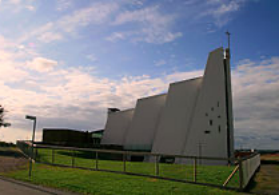
Nærbø Church (Norwegian: Nærbø kirke) is a parish church of the Church of Norway in Hå Municipality in Rogaland county, Norway. It is located in the village of Nærbø. It is the main church for the Nærbø parish which is part of the Jæren prosti (deanery) in the Diocese of Stavanger. The stone and glass church was built in a fan-shaped style in 2005 using designs by the architect Gunnar Fossen from the firm Brandsberg-Dahls Arkitektkontor AS. The church seats about 500 people. This church was built in 2005 to replace the Old Nærbø Church which was nearly 200 years old and too small for the community. This church cost about 44 million kr to build.
2. Old Nærbø Church
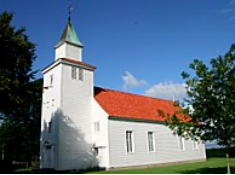
Old Nærbø Church is a parish church of the Church of Norway in Hå Municipality in Rogaland county, Norway. It is located in the village of Nærbø. It used to be the main church for the Nærbø parish which is part of the Jæren prosti (deanery) in the Diocese of Stavanger. The white, wooden church was built in a long church style in 1834 using designs by the architect Hans Linstow. The church seats about 350 people.
In 2005, the "new" Nærbø Church was built on the other side of the village to replace this church. After the completion of the new church, this church was no longer used for regular worship services and other activities. This church is now only used for special occasions.
3. Kvassheim Lighthouse
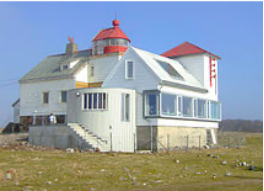
Kvassheim Lighthouse (Norwegian: Kvassheim fyr) is a coastal lighthouse located on the beach at Kvassheim in Hå municipality in Rogaland county, Norway. The lighthouse is located about 2.5 kilometers (1.6 mi) south of the village of Vigrestad. The original building was established in 1912 and automated in 1984. In 1990, the lighthouse was replaced with a smaller, automated lighthouse located about 70 meters (230 ft) to the west of the old building. The old building is now used as a museum and landmark.
The present lighthouse is on a 9.3-meter (31 ft) tall concrete post that is painted with red and white horizontal bands. The light on top sits at an elevation of 11.7 meters (38 ft) above sea level. The 26,400-candela light emits a white, red, or green light (depending on direction) occulting twice every 8 seconds.
The original wooden lighthouse was built in 1912 and it has been inactive since 1990. The 12-meter (39 ft) tall lantern and gallery are centered on the roof of a 1-1 / 2 story wood keeper's house. The building is painted white and the lantern is red. In 2003, the management of the old station was transferred to the Jæren Friluftsråd (Recreation Council), which began restoration work the following winter. The building now includes a cafeteria and a small museum. The site and lighthouse are open daily from late June to mid-August and on Sundays and holidays during the rest of the year except January.
六、历史文化
1.历史
The parish of Haa was established as a municipality on 1 January 1838 (see formannskapsdistrikt law). In 1894, the municipality of Haa was dissolved and divided into two new municipalities: Nærbø (population: 1,806) and Varhaug (population: 1,801). During the 1960s, there were many municipal mergers across Norway due to the work of the Schei Committee. On 1 January 1964, the municipality of Hå was recreated by merging of the neighboring municipalities of Nærbø (population: 3,926), Varhaug (population: 3,454), and Ogna (population: 1,470). In local politics, the divisions between the three previous municipalities are very visible.
The municipality is named after the old Hå farm (Old Norse: Háar) where the local church priest's parsonage was located. The meaning of the name is unknown. The river running past this farm is similarly named the Hååna, meaning the "Hå river". It is not known if the river is named after the farm or vice versa.
The coat of arms was granted on 5 July 1991. The arms are black with a silver / white winch in the center. It is a special type of winch that has historically been used in this area to remove stones from the many farm fields. The arms were chosen to symbolize the hard living on the rocky soils of the municipality.
The name Hå is associated with the rectory Hå and the river Hååna. Prestegården has been transformed into the cultural center Hå Gamle Prestegard. Hå was established as Hå presidency district in 1837, and became Hå municipality in 1853. In 1894, Hå municipality disappeared from history - temporarily. It then had 3,607 inhabitants and was divided into two practically equal municipalities: Nærbø and Varhaug. Hå municipality re-emerged in 1964 when the municipalities of Nærbø, Varhaug and Ogna were merged into one. Today's municipality covers an area of 254 km², and has 14,883 inhabitants (January 1, 2006). The railway was built through the municipality in the 1870s and towns grew up around the stations that were built.
2. 文化体育
The biggest tourist attraction in the municipality is the beach zone with its rich bird and plant life, beaches and breaking sea waves, high skies and a changing light. A footpath has been built that follows the old Kongeveien along the sea. At Varhaug there was a church in the 13th century, but it is gone. The cemetery is still there. At the end of Hååna there are several tombs from the Iron Age and there is also Hå Gamle Prestegard which today is used for exhibitions. At Nærbø is also the Jærmuseet.
There are 4 large multi-sport teams with their own halls and large outdoor facilities, in addition to many small and large special sports teams. The team has offers for all age groups within regular team sports etc. and a common goal of prioritizing mass sports over elite.
七、其他信息
All municipalities in Norway, including Hå, are responsible for primary education (through 10th grade), outpatient health services, senior citizen services, unemployment and other social services, zoning, economic development, and municipal roads. The municipality is governed by a municipal council of elected representatives, which in turn elect a mayor. The municipality falls under the Jæren District Court and the Gulating Court of Appeal. The municipal council (Kommunestyre) of Hå is made up of 33 representatives that are elected to four year terms.
八、联系方式
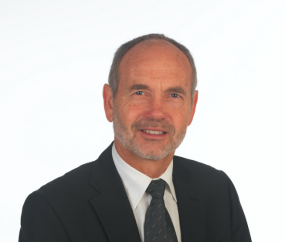
Town manager: Jonas Skrettingland
Phone:51 79 30 00
Address:Hå municipality, Rådhusgata 8, 4360 Varhaug
